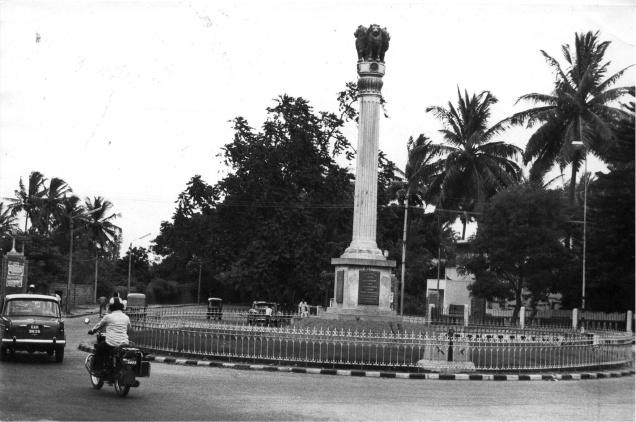The Ashoka Pillar, built in 1948 to mark what was then considered the southern end of the city, has become the enduring landmark of the area. Photo: The Hindu Archives
(S. K. ARUNI)
Bangalore has a legacy of forming layouts based on demographic groups: during the colonial period for instance, the Cantonment became identified with Europeans, while Whitefield was formed for Anglo-Indians; and when Basavanagudi and Malleswaram were formed in the pre-Independence period, the tradition continued.
However, Jayanagar and other areas that were formed after Independence established a new heterogeneous order and became cosmopolitan, owing to the large number migrants there. They discontinued homogeneous cultural bonds and formed a new pluralist society.
The Ashoka Pillar, built in 1948 to mark what was then the southern end of the city has become the enduring landmark of the area.
Right till the 1960s, Jayanagar was considered one of the largest urban settlements in Asia. Then a suburb, built as a southern extension to the city, it saw the transformation of several villages into a developed area. This sprawling locality, spanning nine blocks, comprises Siddapur, Yediyur, Thayappanahalli, Bairasandra, Karisandra, Kattapalya, Ragigudda, and parts of Sarakki and Lakkasandra villages.
The region around Jayanagar came under the control of Kempe Gowda in the 16th century. He dug several lakes in the area to support agriculture. Yediyur, Bairasandra, Lalbagh, Sadduguntapalya and Marenahalli are some of the lakes near the area.
Jamboo savari or Dasara festival processions used to take place in this area. There is an old inscription from the Wadiyar period at Kothnur that mentions this festival.
There is also evidence of stone tools dating back 10,000 years found near Ragigudda, indicating that this area was once inhabited. Iron Age (3,000 years ago) burials were discovered near Lalbagh lake in 1932 by M.H. Krishna, then director of the Archaeology Department of the Princely Mysore State.
The author is Deputy Director, Indian Council of Historical Research, Southern Regional Centre, Bangalore. Mail him at skaruni@gmail.com

